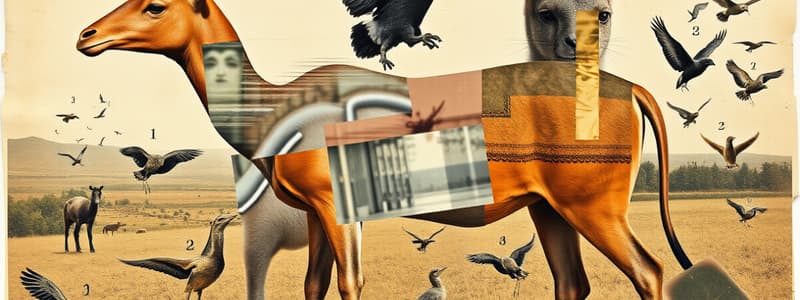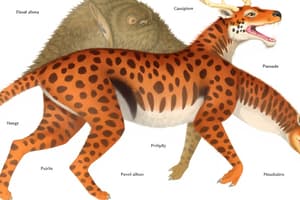Podcast
Questions and Answers
What percentage of all animals are invertebrates?
What percentage of all animals are invertebrates?
- 75%
- 25%
- 97% (correct)
- 50%
What distinguishes animals from plants in terms of nutrition?
What distinguishes animals from plants in terms of nutrition?
- Animals cannot make their own food. (correct)
- Plants are multicellular organisms.
- Animals can produce their own food.
- Plants cannot use sunlight.
Which class of vertebrates includes animals that breathe through gills and live in water?
Which class of vertebrates includes animals that breathe through gills and live in water?
- Mammals
- Fish (correct)
- Reptiles
- Amphibians
During which life stage do amphibians primarily breathe through gills?
During which life stage do amphibians primarily breathe through gills?
What key feature separates vertebrates from invertebrates?
What key feature separates vertebrates from invertebrates?
What distinguishes mammals from reptiles in terms of reproduction?
What distinguishes mammals from reptiles in terms of reproduction?
Which feature is characteristic of birds but not of reptiles?
Which feature is characteristic of birds but not of reptiles?
How do amphibians and reptiles differ in their temperature regulation?
How do amphibians and reptiles differ in their temperature regulation?
Which of the following animals is NOT mentioned as a type of mammal?
Which of the following animals is NOT mentioned as a type of mammal?
What common characteristic do reptiles share with amphibians regarding reproduction?
What common characteristic do reptiles share with amphibians regarding reproduction?
Flashcards are hidden until you start studying
Study Notes
Animal Kingdom Overview
- Kingdom Animalia is one of the five kingdoms of living organisms: plants, fungi, protista, monera, and animalia.
- Animals are multi-cellular and cannot produce their own food, distinguishing them from plants.
- Animal cells lack cell walls, making them visually different from other life kingdoms.
- The animal kingdom is the largest, with many diverse species present in various environments around the globe.
Classification of Animals
- Animals are classified into two main groups: vertebrates (species with a backbone) and invertebrates (species without a backbone).
- Invertebrates comprise approximately 97% of all animal species, with over a million identified and many millions more estimated to exist.
- Vertebrates include around 60,000 known species and are categorized under the phylum Chordata.
Vertebrate Classes
-
Fish:
- Live in water, breathe through gills, covered in scales, and are ectothermic.
- Most reproduce externally by laying fertilized eggs outside their bodies.
-
Amphibians:
- Examples include frogs and toads.
- Begin life as larvae in water, breathing through gills; undergo metamorphosis to become adults.
- Adults have lungs and can absorb water through their skin, allowing them to hibernate underwater.
- Also ectothermic, with external reproduction.
-
Reptiles:
- Include snakes, turtles, lizards, crocodiles, and extinct dinosaurs.
- Ectothermic, scaly, and breathe air using lungs.
- Reproduce internally; eggs are fertilized within the female and typically laid outside.
-
Birds:
- Closely related to reptiles, characterized by feathers and endothermic nature.
- Maintain a constant warm body temperature regardless of the environment.
- Generally, birds can fly, but some, like penguins and ostriches, are flightless.
-
Mammals:
- Endothermic, breathe via lungs, and most reproduce internally, giving birth to live young instead of laying eggs.
- Unique for feeding young with milk from specialized glands.
- Varied environments: while many are hairy and terrestrial, others like whales are smooth-skinned and aquatic; some mammals like bats can fly.
- Humans are classified as mammals in the order of primates and family of great apes.
Key Features Summary Table
| Body | Breathing | Skin | Reproduction | Other Features |
|---|---|---|---|---|
| Fish | Gills | Scales | External, lay eggs | Ectothermic |
| Amphibians | Gills (larvae), lungs | Moist skin | External, undergo metamorphosis | Ectothermic |
| Reptiles | Lungs | Scales | Internal fertilization, lay eggs | Ectothermic |
| Birds | Lungs | Feathers | Lay eggs | Endothermic |
| Mammals | Lungs | Hair | Internal, live birth | Milk feeding to young |
Studying That Suits You
Use AI to generate personalized quizzes and flashcards to suit your learning preferences.




